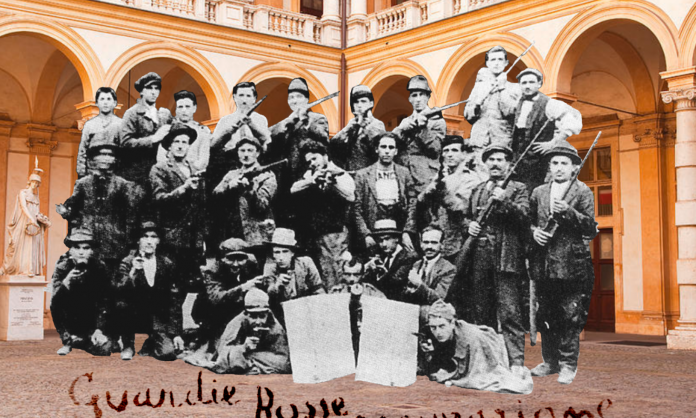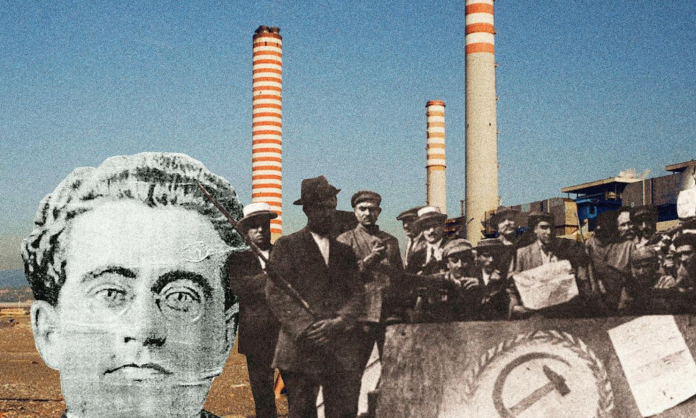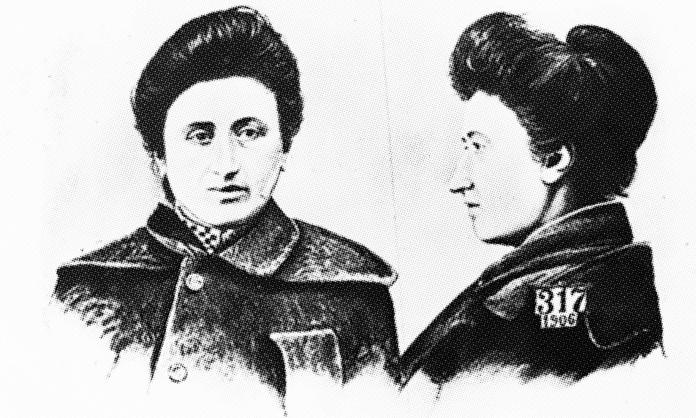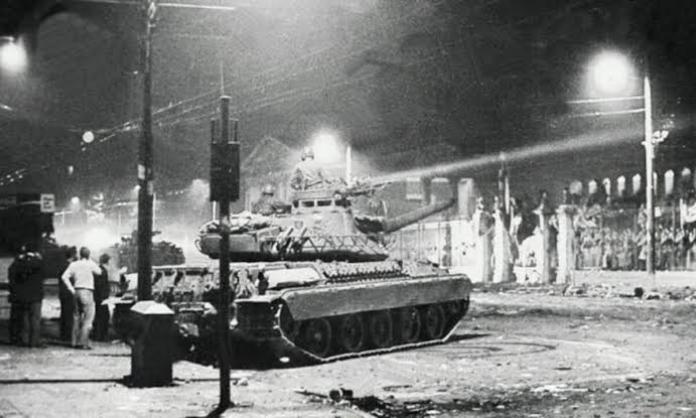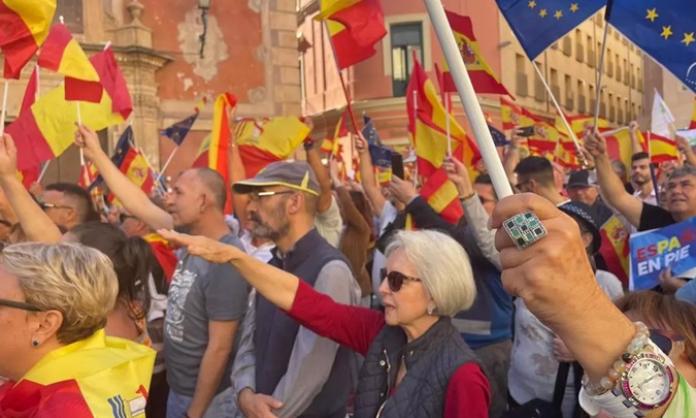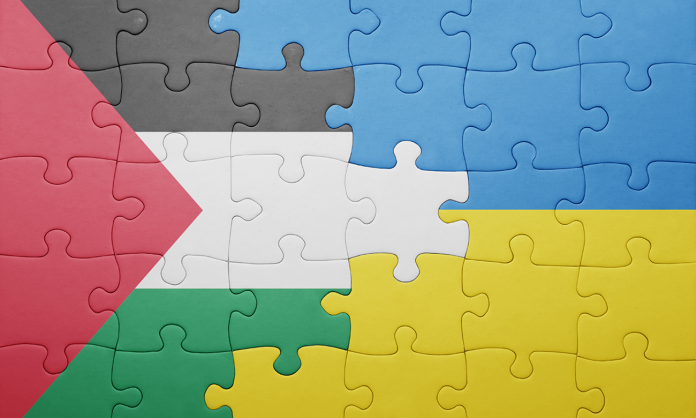By the end of 1919, Turin’s factory council movement had drawn 150,000 workers into militant shopfloor organising, under the radical influence of the Marxist current associated with Antonio Gramsci. The movement’s leaders were exhilarated by the explosive growth of what they called “a practical experiment in the achievement of communist society”. However, as in all class struggle, every victory brought with it new challenges.
Bosses in the metal industry founded Confindustria, an employers’ organisation dedicated to confronting the workers’ movement head-on. Confindustria declared war on the council movement and began campaigning for aggressive government intervention. The very first fascist organisations, bankrolled by the bosses, began attacks on local PSI headquarters.
There was polarisation on the left as well. In the south, peasant land occupations surged, and this traditionally conservative section of the population became receptive to revolutionary ideas.
Class confrontation was growing. Many expected a civil war. That brought the question of political organisation to the fore of Gramsci’s thought. A revolutionary party was clearly needed to unite the fragmented and localised struggles of workers and peasants and confront the capitalist state.
Gramsci had spent his political life building Italy’s Socialist party, the PSI. He was not only a party intellectual, but also an active organiser. He hoped that the party would rise to the challenge. In early writings, he predicted that the councils themselves would provide a basis for shaking the party out of its inertia, allowing it to break with the weight of tradition and provide leadership to the movement. There was some cause for hope: At the Bologna party conference in October 1919, the PSI formally committed itself to the revolutionary overthrow of capitalism.
But this was a tragic case of a party leadership using radical rhetoric to obscure their practical accommodation to capitalism. Their real attitude was revealed when they were challenged to move beyond mouthing revolutionary slogans. The Turin party section appealed to the PSI leadership to help generalise and spread the council movement. Instead, the party leaders attacked the movement. Turati’s reformists saw, and feared, the potential for the councils to pose a direct challenge to the trade union bureaucracy and parliamentarians. Serrati’s supposedly left-wing Maximalists were horrified at the idea that non-union workers could vote for representatives: he derided this as “anarchism”.
Remarkably, the revolutionary extremist Bordiga also disavowed the councils. He based his hostility to the movement on the idea that workers’ control of production was a reformist illusion so long as the capitalist state prevailed. Bordiga correctly identified the limitations of the current movement: if the councils did not fight for and win political power, they would also be unable to exercise true economic power in the workplace.
But Bordiga did not share Gramsci’s interventionist approach to workers’ struggles. Bordiga made no argument for providing revolutionary leadership to the powerful movements already built by militant workers, in order to develop it into a revolutionary challenge to the state. Instead of workers’ power emerging organically through working class struggle, Bordiga thought the institutions of working class government would be decreed from above after the Communist Party’s victory. “Tomorrow’s soviets will have their genesis in the local sections of the Communist Party,” Bordiga wrote. “These sections should make ready the elements that, immediately after revolutionary victory, will be offered to the vote of the proletarian electoral mass, in order to create the local delegates’ councils.”
Bordiga therefore shared with Serrati and Turati a fundamental assumption of Second International Marxism: that the rule of the working class meant the rule of the party.
Gramsci developed a critique of the PSI defensively, in response to attacks from his rivals. His critique reflects a one-sidedness in his assimilation of the Russian experience. Gramsci saw the development of a “conciliar” theory of workers’ revolution, as expressed in Lenin’s State and Revolution, as the main contribution of the Bolsheviks. He understood that workers’ struggles in the workplace could develop workers’ councils that could form the basis for a revolutionary democratic state. Unlike both Bordiga and the reformists, Gramsci recognised the indispensable role of organic workers’ struggles building step-by-step towards the revolutionary overthrow of capitalism. But unlike the Bolsheviks, he did not understand the need for a party to participate in and help lead these struggles: to advance the tendencies toward working-class self organisation, and combat the reformist forces which attempted to constrain them. This realisation was to dawn on Gramsci too late, as the struggle was nearing its climax.
The PSI’s leaders refused to lend support to the Turinese workers when they were locked out in April 1920 by their employers. This provocation sparked a general strike which brought out 500,000 workers, and drew in millions behind it. Mario Montagna wrote: “For eleven days the life of the city and province remained completely paralysed. Tramways, railways, public services and many private businesses stopped work, in addition to the whole of industry.” The movement’s impact was felt well beyond Turin. Peasant strikers created their own institutions and forged links with industrial workers.
While the strikers fought bitterly to defend the councils, the PSI newspaper Avanti! refused to print their appeals for assistance. Turin was surrounded by machine guns, cannons and 50,000 troops–but in the end, the ruling class had no need to resort to open warfare. Isolated and demoralised, the strikers returned to work after a month. At the party’s Milan conference, Gramsci denounced the leadership for its bureaucratism and passivity: “The Socialist Party watches the course of events like a spectator”, he said.
But the April strike also posed starkly the limits of the opposition currents within the party. As the most prominent representative of the radical left, Bordiga had an immense responsibility to offer alternative leadership to the movement. Instead, he offered only doctrinal criticism, stating that its defeat confirmed his suspicions of the movement.
While Gramsci’s Ordine Nuovo group threw themselves into the struggle, they offered no strategy for taking it forward. For the duration of the strike, they suspended their publication, leaving their faction without a political platform.
Outside the PSI, the most important radical grouping were the anarcho-syndicalists. They were heavily involved in the Turinese council movement, and played an instrumental role in organising the April struggle. They led successful strikes which shut down railways and ports to halt the transport of troops sent to crush the movement, and issued clear national appeals for solidarity, urging: “Don’t let the army converge on Turin. Don’t be accomplices to a massacre.” The anarcho-syndicalists tenaciously threw themselves into struggle, but militant action by a minority was not enough to dislodge the reformist leadership of the PSI and the trade unions. Gramsci’s reluctance to split from the PSI prevented him from organising with the anarcho-syndicalists.
The occupation of the factories
The defeat of the April strikes was a setback for the council movement, but it didn’t halt the rising tide of militancy across the country. A wage dispute in September 1920 between the major employers in the North and the metalworkers’ unions exploded in the atmosphere of extreme social tension.
Working class living standards were being savaged by wartime inflation. Metalworkers were frustrated with conciliatory union leaders. Bosses wanted action against workers. The capitalist Rotigliano, later a prominent backer of Mussolini, declared as negotiations broke down: “There will be no concessions. Since the end of the war, we’ve done nothing but drop our pants. Now it’s our turn to start on you.”
At the very end of August, bosses at the Romeo plant in Milan shut the gates on their 2,000 employees. In response workers occupied 300 factories in Milan. Metalworks bosses ordered a lock-out across the country, and a tidal wave of factory occupations occurred. Half a million workers raised red and black flags over their factories, armed themselves, and prepared for a decisive struggle for control of production.
The meaning of workers’ control varied across the major industrial centres. In Turin, with more than a year of experience in self-organisation, the factory councils progressively took on more elements of control. At FIAT-Centro, the council met permanently and established commissions to take stock of inventory and raw materials, to organise transport and create an armed red guard. Virtually every metalworks was involved in producing weaponry for the movement’s self-defence.
The explosion of workers’ self-organisation scared the bourgeoisie. Some factory councils found they were able to secure loans from commercial banks to purchase raw material and fuel. Bankers were hoping to curry favour with workers in case they successfully seized power!
Many councils demonstrated workers’ self-discipline and vigilance. Alcohol was strictly forbidden and theft of equipment was punished severely by the factory councils. This was driven both by a desire to win popular support for their occupations, but also a profound sense that they were attempting to model a new moral society inside the factory walls.
On the other side, there was festivity and enthusiasm, a genuine atmosphere of euphoria. Gramsci spoke at the first Sunday gathering of occupying workers on September 5th, at FIAT-Garrone, underlining the historic nature of the event: “Social hierarchies have been smashed and historical values turned upside down.”
However, he warned, the occupation of factories was not the same thing as a political seizure of power. “It indicates the extent of the proletariat’s power,” he said, but “it does not in or of itself produce any new, definite position. Power remains in the hands of capital; armed force remains the property of the bourgeois state.” How this political seizure of power would be carried out, however, was never clarified by the Turin revolutionaries. Gramsci did not yet have a conception of how to move from council organisation to an overthrow of existing society. His theory of revolution was missing an understanding of the need for insurrection – the organised dismantling of the institutions of capitalist repression and administration.
‘Those who make a revolution half-way dig their own graves’
When the industrialist Agnelli demanded the state intervene to wrest the factories back, Prime Minister Giolitti asked if he was happy for his factory to be the first to be bombarded. No capitalist was prepared to have their machinery and buildings destroyed while others remained in operation. Giolitti’s alternative strategy allowed the ruling class to gain the upper hand. Rather than confront the occupations head-on, Giolitti decided to wait them out, and put his hopes in the desire of the socialist leaders for compromise.
From September 9, representatives of the CGL union federation and PSI met in Milan to attempt to find a way out of the conflict. The reformist union leaders called the bluff of the PSI directorate, offering their resignations and pledging loyalty to the course of revolution, if the PSI were willing to lead it. Faced with a situation which marked a decisive break from normalcy, a working class under arms and half a million in control of their factories, the PSI leaders retreated. They decided to put the question of revolution to a vote.
Two motions were put to the national membership of the CGL. One, moved by the union bureaucrats, called for recognition of union participation in management–the most right-wing form of “workers’ control”, in which union leaders are given the privileges of capitalist bosses. The other motion, moved by representatives of the Socialist Party, called for the immediate socialisation of the means of production. The socialisation proposal lost narrowly by 591,245 votes to 409,569.
The process was a farce. The PSI leaders had no intention of leading an insurrection, and breathed a heavy sigh of relief when their motion failed. They had done nothing to win support for the occupations outside of the Northern industrial centres, and made no preparations to see the struggle through.
While sections of the ruling class were disconcerted by union claims for participation in management, Giolitti convinced them that it was the best way to regain control and restart production. CGL representatives and factory owners boarded the same train to a summit to negotiate terms. On the train the prefect of Milan, an industrialist who had shot dead two workers two nights earlier, pointed to the union leader D’Aragona and declared “You see him? He’s the saviour of Italy.”
The return to work was uneven. Some workers held for a month against all odds, isolated and abandoned by their leadership. By November, a wave of fascist terror began to sweep the country, and it became clear that the revolutionary period had come to an end. The capitalist class had weathered the ”Two Red Years.
The lessons of defeat
The experience of the factory councils was a decisive episode in the development of Gramsci’s revolutionary politics. Writing years later, imprisoned by the victorious fascist regime, he constantly reflected on this period. Gramsci drew two decisive lessons.
The first was the necessity of a revolutionary party to lead the workers’ movement to victory. Gramsci had placed enormous faith in the spontaneous, creative potential of working class struggle. The movement proved that this power could accomplish wonders. In the direst conditions, workers demonstrated the historic obsolescence of the capitalists by placing workplaces under their own control.
Permanently defeating an organised and united capitalist class and their state, however, is another matter. Without a revolutionary party capable of pushing past moments of hesitation, generalising struggle across the working class and challenging forces which ultimately want to contain it, the councils would never reach their full potential. Ultimately, no organised force ever systematically made a strategic argument about how to proceed from the occupations to the defeat of the capitalist state and the socialist reorganisation of society.
Tragically, when the necessity of revolutionary leadership was posed most starkly in August and September, Gramsci sidestepped the question. He remained a captive of the PSI’s reformist majority. He didn’t build a revolutionary faction that could lead a split until it was too late. This organisational mistake intertwined with the gaps in Gramsci’s strategic outlook. He entertained the possibility that the council movement in and of itself could overcome a reformist framework and take power. In this context, the question of building a new party was not so urgent.
If Gramsci had attempted to more seriously gather forces around revolutionary perspectives, it would have been possible to win support from radicals both inside and outside the PSI. He was highly respected by the anarcho-syndicalists who collaborated with him in the council movement. While the anarcho-syndicalists wrongly believed that industrial organising alone was enough to topple the rule of the capitalist class, they were also some of the most sincere worker militants in the country. Instead of attempting to win them to revolutionary Marxism, Gramsci displayed a dismissive attitude, deriding their “pseudo-revolutionary rhetoric”.
Bordiga had a clearer understanding of the need to split from the reformists, but the party he wanted to build was not one that enmeshed itself in the daily struggles of workers and the oppressed, and fought to win a majority. Bordiga wanted to create a narrow, rigid Communist Party which would maintain its ideological purity by abstaining from action, and passively await the great day when it came to power.
By the time of the Livorno Congress of the PSI in January 1921, a split in the party had become inevitable. Debate at the conference over the failure of the councils and the role of the party was so heated that at one point the radical Bombacci drew a revolver. The delegates could only be calmed by frequent intermissions to sing the Internationale. Eventually, the revolutionaries walked out of the conference to found a Communist Party, but they paid a heavy price for their disorganisation. The lack of preparatory work to organise opposition to the reformist leadership of the party meant they left with a minority of the PSI’s members. Politically, their new party was dominated by Bordiga and shaped by his abstentionist, sectarian attitude. By the time the young Communist Party found its feet, it was already fighting for survival against the fascist threat, and its sectarian leadership were not equipped for this challenge.
The second lesson Gramsci drew was a deeper understanding of the meaning of working class leadership. Gramsci’s early theorisation of the councils focused narrowly on the factory as the “national territory” of the working class. This conception limited revolutionary struggles to control over production.
In order to challenge capitalism, workers need to assert themselves outside the factory walls as well. To rally the social forces necessary to challenge the old order, workers in Italy needed to build institutions capable of taking up the demands of other oppressed classes and social groups.
This was a key neglected lesson from the Russian Revolution: the ability of the soviets to act as a political tribune of the oppressed, not just as economic institutions to control factories. This political approach allowed workers’ councils in Russia to win the loyalty of mutinying soldiers, rebellious peasants, and religious and national minorities – building a coalition under the leadership of revolutionary workers that destroyed the capitalist state.
The radicalisation in Italy had touched layers well beyond the industrial working class. Peasants and sharecroppers in Southern and Central Italy revolted and occupied the land, forcing their landlords to negotiate for the first time. Returning soldiers polarised, with some joining the ranks of the revolutionary left and others making up the ranks of the first fascist militias. The factory councils, limited to questions of production, were unable to create an alternative pole to the capitalist state, to represent the demands of these groups and win them to the project of reconstituting society through workers’ power.
Increasingly, the question would come to occupy Gramsci. His essay on the “Southern Question”, urging the working class to forge an alliance with impoverished peasants, was the last major work he published before his imprisonment in 1926. Gramsci’s Prison Notebooks–a decade’s worth of writing on politics, philosophy, and history–are the final product of this reflection on his revolutionary activity. The unifying theme of the Notebooks is his theory of hegemony. This concept preserves his essential insight that workers’ power needs to be organised at the point of production, and combines it with a political argument about the necessity of exercising revolutionary leadership over a united movement of the oppressed.
While more is probably written about Gramsci than any other Marxist intellectual of his generation, most accounts sever the link between his early revolutionary experience and later theoretical elaboration. “During the lifetime of great revolutionaries”, Lenin wrote in State and Revolution, “the oppressing classes constantly hounded them, received their theories with the most savage malice, the most furious hatred and the most unscrupulous campaigns of lies and slander. After their death, attempts are made to convert them into harmless icons, to canonise them.” This accurately describes the fate of Antonio Gramsci.
Gramsci was physically broken by Mussolini’s fascist regime. The fascist prosecutor who sentenced him to imprisonment declared: “For 20 years we must stop this brain from functioning.” He died at the age of 46, a few days after his release from prison. After death, he suffered another indignity: reformist socialists claimed him as the patron saint of a strategy of gradual parliamentary change.
But any attempt to reckon with Gramsci’s immense contributions to Marxist theory must take his years in Turin as a starting point. At the age of 26, Gramsci was thrust by accident into the leadership of the workers’ movement. By 28, he was attempting to grapple with a practical strategy for ending capitalist exploitation.
The commitment he developed in these years would shape the rest of his intellectual life. He lived and died a revolutionary. This was a commitment not just to academic ideas, but to real workers, “‘of flesh and blood”, as he called them in a tribute to the FIAT strikers after the betrayal of 1920. This tribute commemorates the sacrifice that these workers made and embodies Gramsci’s deep attachment to their cause:
“The Italian working class is flattened under the roller of capitalist reaction. For how long? Nothing is lost if consciousness and faith is left intact, if bodies surrender but not souls. The workers of FIAT have struggled hard for years. They have bathed the streets in their blood. They have suffered hunger and cold. They remain, with their glorious past, the vanguard of the Italian proletariat. They remain faithful and devoted soldiers of the revolution.”
Gramsci had absorbed that crucial lesson of revolutionary organising: the role of Marxists is not just to interpret history, but to preserve the collective memory of the working class at its most militant. Revolutionary consciousness cannot just be passively awaited; it must be built and renewed by an interventionist party with a clear political line and a basis in the organic movements of the working class.
Read part one of this two-part series.




